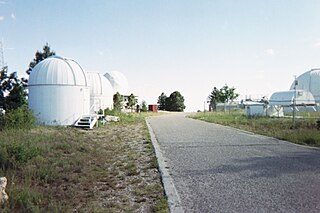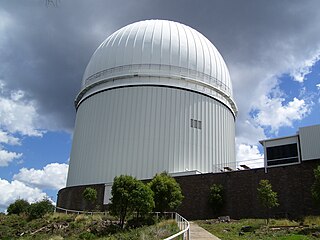
The Kitt Peak National Observatory (KPNO) is a United States astronomical observatory located on Kitt Peak of the Quinlan Mountains in the Arizona-Sonoran Desert on the Tohono Oʼodham Nation, 88 kilometers (55 mi) west-southwest of Tucson, Arizona. With more than twenty optical and two radio telescopes, it is one of the largest gatherings of astronomical instruments in the Earth's northern hemisphere.

Lowell Observatory is an astronomical observatory in Flagstaff, Arizona, United States. Lowell Observatory was established in 1894, placing it among the oldest observatories in the United States, and was designated a National Historic Landmark in 1965. In 2011, the Observatory was named one of "The World's 100 Most Important Places" by Time Magazine. It was at the Lowell Observatory that the dwarf planet Pluto was discovered in 1930 by Clyde Tombaugh.

The Mauna Kea Observatories (MKO) are a group of independent astronomical research facilities and large telescope observatories that are located at the summit of Mauna Kea on the Big Island of Hawaiʻi, United States. The facilities are located in a 525-acre (212 ha) special land use zone known as the "Astronomy Precinct", which is located within the 11,228-acre (4,544 ha) Mauna Kea Science Reserve. The Astronomy Precinct was established in 1967 and is located on land protected by the Historical Preservation Act for its significance to Hawaiian culture. The presence and continued construction of telescopes is highly controversial due to Mauna Kea's centrality in native Hawaiian religion and culture, as well as for a variety of environmental reasons.

Steward Observatory is the research arm of the Department of Astronomy at the University of Arizona (UArizona). Its offices are located on the UArizona campus in Tucson, Arizona (US). Established in 1916, the first telescope and building were formally dedicated on April 23, 1923. It now operates, or is a partner in telescopes at five mountain-top locations in Arizona, one in New Mexico, one in Hawaii, and one in Chile. It has provided instruments for three different space telescopes and numerous terrestrial ones. Steward also has one of the few facilities in the world that can cast and figure the very large primary mirrors used in telescopes built in the early 21st century.

The Cerro Tololo Inter-American Observatory (CTIO) is an astronomical observatory located on the summit of Mt.Cerro Tololo in the Coquimbo Region of northern Chile, with additional facilities located on Mt. Cerro Pachón about 10 kilometres (6.2 mi) to the southeast. It is approximately 80 kilometres (50 mi) east of La Serena, where support facilities are located. The site was identified by a team of scientists from Chile and the United States in 1959, and it was selected in 1962. Construction began in 1963 and regular astronomical observations commenced in 1965. Construction of large buildings on Cerro Tololo ended with the completion of the Víctor Blanco Telescope in 1974, but smaller facilities have been built since then. Cerro Pachón is still under development, with two large telescopes inaugurated since 2000, and one in the final stages of construction as of 2023

Mount Graham is a mountain in Graham County, Arizona, United States, approximately 70 miles (110 km) northeast of Tucson. The mountain reaches 10,724 feet (3,269 m) in height. It is the highest elevation in Graham County, Coronado National Forest and the Pinaleño Mountains. It is also the southernmost peak and land area in the continental United States above 10,000 feet (3,048 m). As the name "Mount Graham" is often used by locals to refer to the entire mountain range, the peak itself is frequently referred to as "High Peak". It is twentieth of the 57 ultra-prominent peaks of the lower 48 states, and the first of the five in Arizona.

Catalina Sky Survey is an astronomical survey to discover comets and asteroids. It is conducted at the Steward Observatory's Catalina Station, located near Tucson, Arizona, in the United States.

George A. Van Biesbroeck was a Belgian–American astronomer. He worked at observatories in Belgium, Germany and the United States. He specialized in the observation of double stars, asteroids and comets. He is notable for his long career as an observational astronomer.

The Stratospheric Observatory For Infrared Astronomy (SOFIA) was a 80/20 joint project of NASA and the German Aerospace Center (DLR) to construct and maintain an airborne observatory. NASA awarded the contract for the development of the aircraft, operation of the observatory and management of the American part of the project to the Universities Space Research Association (USRA) in 1996. The DSI managed the German parts of the project which were primarily science-and telescope-related. SOFIA's telescope saw first light on May 26, 2010. SOFIA was the successor to the Kuiper Airborne Observatory. During 10-hour, overnight flights, it observed celestial magnetic fields, star-forming regions, comets, nebulae, and the Galactic Center.

Mount Lemmon, with a summit elevation of 9,159 feet (2,792 m), is the highest point in the Santa Catalina Mountains. It is located in the Coronado National Forest north of Tucson, Arizona, United States. Mount Lemmon was named for botanist Sara Plummer Lemmon, who trekked to the top of the mountain with her husband and E. O. Stratton, a local rancher, by horse and foot in 1881. Mount Lemmon is also known as Babad Do'ag, or Frog Mountain to the Tohono O'odham.

The MMT Observatory (MMTO) is an astronomical observatory on the site of Fred Lawrence Whipple Observatory. The Whipple observatory complex is located on Mount Hopkins, Arizona, US in the Santa Rita Mountains. The observatory is operated by the University of Arizona and the Smithsonian Institution, and has a visitor center in nearby Amado, Arizona. The MMTO is the home of the MMT, which has a primary mirror 6.5 m in diameter. The name comes from the six smaller mirrors originally used before the single primary mirror was installed in 1998. The primary mirror has a special lightweight honeycomb design made by the University of Arizona's Steward Observatory Mirror Laboratory. The MMT is housed in a building which allows the walls and roof around the telescope to be completely rolled back, allowing it to cool down very quickly in order to improve observation.

Mount Laguna Observatory (MLO) is an astronomical observatory owned and operated by San Diego State University (SDSU). The telescope was operated in partnership with the University of Illinois at Urbana-Champaign (UIUC) until 2000. MLO is located approximately 75 kilometers (47 mi) east of downtown San Diego, California (USA) on the eastern edge of the Cleveland National Forest in the Laguna Mountains on the SDSU Astronomy Campus near the hamlet of Mount Laguna. MLO was dedicated on June 19, 1968, seven years after SDSU's Department of Astronomy became an independent academic department of SDSU's College of Sciences. The dedication took place during the 1968 summer meeting of the Astronomical Society of the Pacific. Currently SDSU is working with University of Kansas (KU), and UNC Chapel Hill on various projects. MLO also engages with the public through a series of scientific outreach efforts such as the summer visitors program (SVP). SVP's take place on select dates throughout the summer months and include scientific demonstrations in the museum / gift shop, an introductory lecture on astronomy, and a stargazing session using a myriad of telescopes such as the 0.52 m Reginald Buller 21-inch Visitors' Telescope. The SVP is predominantly run by graduate students within the SDSU Astronomy Master's program.

Mount Graham International Observatory (MGIO) is a division of Steward Observatory, the research arm for the Department of Astronomy at the University of Arizona, in the United States. It is located in southeastern Arizona's Pinaleño Mountains near Mount Graham. During development, it was first called the Columbus Project.

Mount Lemmon Observatory (MLO), also known as the Mount Lemmon Infrared Observatory, is an astronomical observatory located on Mount Lemmon in the Santa Catalina Mountains approximately 28 kilometers (17 mi) northeast of Tucson, Arizona (US). The site in the Coronado National Forest is used with special permission from the U.S. Forest Service by the University of Arizona's Steward Observatory, and contains a number of independently managed telescopes.

The Siding Spring Survey (SSS) was a near-Earth object search program that used the 0.5-metre Uppsala Southern Schmidt Telescope at Siding Spring Observatory, New South Wales, Australia. It was the southern hemisphere counterpart of the Catalina Sky Survey (CSS) located in the Santa Catalina Mountains on Mount Bigelow, near Tucson, Arizona, USA. The survey was the only professional search for dangerous asteroids being made in the Southern Hemisphere.
Mount Lemmon Survey (MLS) is a part of the Catalina Sky Survey with observatory code G96. MLS uses a 1.52 m (60 in) cassegrain reflector telescope operated by the Steward Observatory at Mount Lemmon Observatory, which is located at 2,791 meters (9,157 ft) in the Santa Catalina Mountains northeast of Tucson, Arizona.

The National Astronomical Observatory is an astronomical observatory in Baja California, Mexico.
Astronomy Camp is a science summer camp hosted by the University of Arizona's Alumni Association, and run by astronomer Don McCarthy. Many of the early camps took place at the Mount Lemmon Station Observatory atop Mount Lemmon, near Tucson, Arizona. On Mount Lemmon, the campers have access to a 12-inch (30 cm), 20-inch, 40-inch and 60-inch telescope, and on the nearby Mount Bigelow site, a 61-inch (150 cm) telescope.
Optics Valley is a region in southern Arizona, centered on Tucson, that is home to a high concentration of optics companies spawned by research at the University of Arizona. Based on the idea of a technology cluster, akin Silicon Valley, Optics Valley is known not only for its optics industry and research but also for the astronomical observatories located in the mountains of southern Arizona. These observatories benefit from clear skies and isolated peaks, creating superior observing conditions.

Catalina Station (CS), also known as Steward Observatory Catalina Station, is an astronomical observing facility located on Mount Bigelow in the Santa Catalina Mountains approximately 29 kilometers (18 mi) northeast of Tucson, Arizona. The site in the Coronado National Forest is used with special permission from the United States Forest Service (USFS) by the Steward Observatory of the University of Arizona.

















